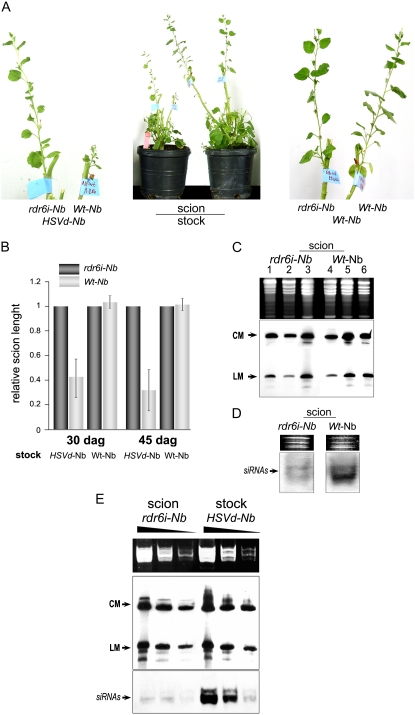Figure 3.
Effects of HSVd accumulation in Wt-Nb and rdr6i-Nb plants. Two-week-old Wt-Nb and rdr6i-Nb scions were grafted onto symptomatic transgenic HSVd-Nb stocks and kept at 28°C. A (middle), General symptoms induced by HSVd in a representative Wt-Nb scion compared with an rdr6i-Nb scion grafted onto an identical HSVd-Nb stock at 45 dag. The left and right panels show magnified images of the grafts. B, Relative length of Wt-Nb and rdr6i-Nb scions grafted onto Wt-Nb and HSVd-Nb plants. The scion length was measured at 30 and 45 dag. Error bars indicate sd values between six analyzed samples. C, Total RNAs were extracted from three different scions at 45 dag and analyzed by northern-blot assays. The HSVd RNA circular (CM) and linear (LM) monomeric form levels were significantly similar in symptomless rdr6i-Nb (lanes 1–3) and symptomatic Wt-Nb (lanes 4–6) scions. D, Small RNA-enriched RNAs were extracted from three pooled rdr6i-Nb and Wt-Nb scions at 45 dag. The RNAs were analyzed by northern-blot assays to detect HSVd-specific siRNAs. E, Total RNAs and small RNA-enriched RNAs were extracted from three pooled rdr6i-Nb scions and their respective HSVd-Nb stocks at 45 dag. The RNAs were diluted 1:1, 1:5, and 1:25 and analyzed by northern-blot assays to detect mature forms and specific siRNAs of HSVd. RNAs were quantified by spectrometry and their concentrations equalized. Ethidium bromide-stained gels are shown as RNA loading controls (in C–E). [See online article for color version of this figure.]

